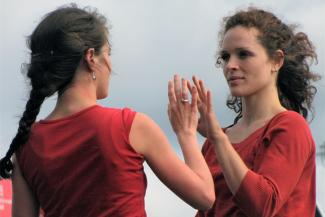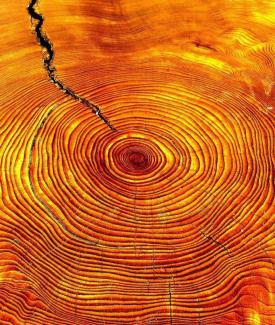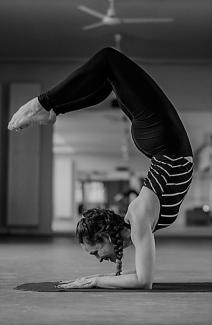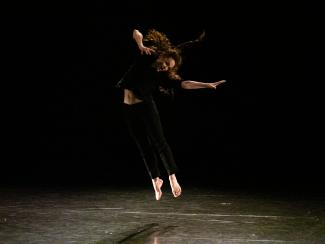Inspired by the contemplation of nature, the study of human anatomy, the acknowledgement of the healing and creative power of movement and sound, my teaching develops through the integration of different dance-theater disciplines, voice training, and bodywork techniques.
Open Source Forms
OSF is a Dance Method rooted in the Skinner Releasing Technique and developed by the New York Choreographer and performer Stephanie Skura.
It Involves shedding outer layers, accessing primal energy, agility navigating subconscious realms, imagery as a potent tool for transformation, developing a high degree of self-consciousness. This work celebrates diversity, collaboration & individual empowerment: free of inhibitions invites the mind to collaborate in the liberation of the body from constructed beliefs. OSF sessions offer powerful tools to access specificity, courage and originality in movement, vocal practice & creative practice. A key aspect is individual and group creative empowerment as instigators of positive change on the planet.
the New York Choreographer and performer Stephanie Skura.
It Involves shedding outer layers, accessing primal energy, agility navigating subconscious realms, imagery as a potent tool for transformation, developing a high degree of self-consciousness. This work celebrates diversity, collaboration & individual empowerment: free of inhibitions invites the mind to collaborate in the liberation of the body from constructed beliefs. OSF sessions offer powerful tools to access specificity, courage and originality in movement, vocal practice & creative practice. A key aspect is individual and group creative empowerment as instigators of positive change on the planet.
Principles in motion – based on Release technique and Body Mind Centering
Considering improvisation a fundamental element in every realm of life, this course proposes new prospective to practice and think about dance techniques. From a place of non-judgment, where the body is receptive and aware, we explore our anatomy, alignment, dynamics, and qualities, in relation to physical principles, that organize and move the body in space - as gravity, buoyancy, synchronicity, complementarity, symmetry; and the pathways of movement - homologous, homo lateral, contralateral. Release Technique is a method that aims to reeducate motility to help the body to find its natural alignment, improving, strength, flexibility and agility. It works and explores biomechanical principles, therefore it can be applied to any other technique. In my class we will analyse and explore the anatomy and kinetics of specific body parts, through improvisation and movement sequences. From the floor to standing, across the floor and upside down. In my class I also introduce fundamental elements of Contact improvisation favoring the exploration of partnering. Becoming aware of the resources within us and the ones that the space offers, we begin to unfold and develop movement in a more organic and effortless ways. We become more receptive, versatile, respecting ourselves and the environment, refining our movement's qualities versus the quantity of our actions. We begin to sense and enjoying intervals, pauses, the suspensions, which help us to create rhyhthms and develop momentum. I wish for every dancer to acknowledge the uniqueness and the amazing force of their bodies, to develop creative, efficient, and sensitive ways of moving.
Contact Improvisation
Contact Improvisation (CI) is a dance form based on the dialogue between weight, balance, reflexes, and impulses in physical contact between two or more bodies in motion. CI was first presented in 1972 at the John Weber Gallery, New York City, conceived and directed by the American choreographer Steve Paxton. Besides developing through a tangible exploration of natural bodily principles, Contact Improvisation is also a continuous exchange of ideas, curiosity, and questions, which allows humour, imagination, and new stories to be generated and shared across cultures, genres, and ages. In her Caught Falling, Nancy Stark Smith writes that there is no single definition of CI because, from the very beginning, it has been communicated primarily through dancing. For this reason, dancers and teachers collected their notes, descriptions and research to document their experiences, and in 1975 a Contact Improvisation journal was created, which still exists today, Contact Quarterly Magazine. While connecting to our weight in dialogue with the earth, we begin to sense the buoyancy, the resilient state of our tissues, becoming supple resilient.
As we connect to our weight in dialogue with the earth, we begin to perceive buoyancy, the resilient state of our tissues, which become elastic and resilient. We will explore some basic CI skills and develop them through different scores, discovering new responses and movement patterns. The course integrates elements of Body-Mind Centering and Axis Syllabus. By observing Paxton's Spine Movement, we will refine our kinaesthetic and proprioceptive awareness. We will experiment and research counterbalancing skills, weight sharing, flips and lifts, finding confidence and competence in practicing duets, trios or group improvisations.

The Permeable Touch Lab
A sensorial kinesthetic journey, exploring the continuous dialogue between our inner and outer landscape. The body is porous, permeable, transforming with its environment. We will refine our awareness, listening throughout our entire skin, and the body will begin to talk about "this very moment".
I Touch while feeling touched, recognizing myself, in the other, the other in and the constant exchange between us and the environment.
Being touch by something can be expression of apparent stillness, but in reality it is the manifestation of the vibration that each and every thing in life radiate.
My interest is to explore the qualities and information that each specific touch - physical or not carries within, and to notice how do we respond to it, initiating and developing dialogues, dances, healing pathways.
 Our starting point is a dive into a deep state of awareness, quite alertness and presence.
Focusing on the "in-tensions," we become conscious of the operating system, which shapes and nurtures the tone of our muscles, bones, skin, organs, and our experience of touch/and being touch.
Our starting point is a dive into a deep state of awareness, quite alertness and presence.
Focusing on the "in-tensions," we become conscious of the operating system, which shapes and nurtures the tone of our muscles, bones, skin, organs, and our experience of touch/and being touch.
Through Movement and sound we will explore the wide range of possibilities that our bodies have to offer. I developed scores and games, inspired by Contact improvisation, Body Mind Centering, Qi gong, Butoh and Voice work studies. We will investigating the different kinds of touch, the action of yielding, and from there, we will experience the rhythms, shapes of each body layer, developing their unique ways to move, connect, touch, and being touched.
OTHER PRACTICES
- Alchemical Flow
- Pilates focused on internal alignment and postural muscles
Advance, beginners and private session - 90 minutes
Alchemical flow
 Each time inspired by the different moon's positions, as a common denominator among all human beings, Alchemical Yoga Flow develops through the 7 Stages of Alchemical transformation - Calcination, Dissolution, Separation,
Conjunction, Fermentation, Distillation, Coagulation.
The moon position will determine which Element the class will focus on and consequentially on which body system. Alchemical Flow combines the dynamic practice of the Vinyasa method, the spiritual path of the Hata Yoga and the dynamic alignment I learned through the study of more than 17 years of somatic practices - including Yoga Therapy, Body-Mind Center and Klein Technique.
Each time inspired by the different moon's positions, as a common denominator among all human beings, Alchemical Yoga Flow develops through the 7 Stages of Alchemical transformation - Calcination, Dissolution, Separation,
Conjunction, Fermentation, Distillation, Coagulation.
The moon position will determine which Element the class will focus on and consequentially on which body system. Alchemical Flow combines the dynamic practice of the Vinyasa method, the spiritual path of the Hata Yoga and the dynamic alignment I learned through the study of more than 17 years of somatic practices - including Yoga Therapy, Body-Mind Center and Klein Technique.

Photos: Jim Coleman, Christian Klant

